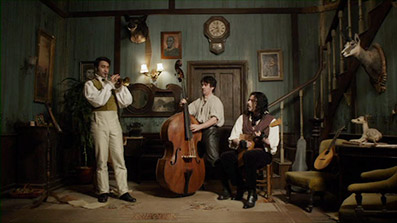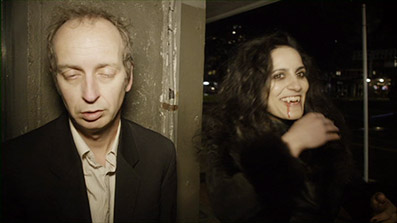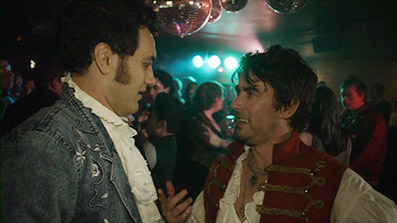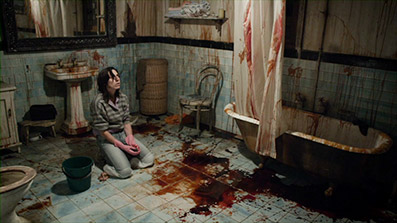| |
"I was obsessed with vampires as a kid, so we're very respectful to vampire mythology. We don't try to break any rules; we try to keep vampire characters. It's not another Scary Movie parody of vampires. We've tried to make them actual characters and stay true to a lot of the folklore and movie-lore about vampires." |
| |
Co-director Jemaine Clement, interviewed at
IndieWire.com* |
| |
"I think of it like this. If you are going to eat a sandwich, you would just enjoy it more if you knew no one had fucked it." |
| |
Vladislav on why vampires prefer the blood of virgins |
Viago, Vladislav, Deacon and Petyr all share a house and have invited a film crew in to document their daily lives. How interesting does that sound? Well how about this: Viago, Vladislav, Deacon and Petyr are vampires, Eastern European émigrés who have settled in a suburban district of Wellington, New Zealand and who use the house as a base for their nefarious nocturnal activities. Now you're talking. Welcome to What We Do in the Shadows.
The idea of exploring the lives of everyday urban vampires through a mockumentary lens is actually not new, having been given its first run back in 2000 in the Vampirology episode of the TV series Urban Gothic. But in the hands of Kiwi directors Taika Waititi and Flight of the Conchords' Jemaine Clement – who also star as Viago and Vladislav – it proves to be a springboard for what has to be the most inventive and enjoyable horror comedy to hit the screen in some years.
Here the cold, calculating and austere vampire of legend is brought down to earth, stripped of its dark glamour and transformed into the sort of goof you've probably had as a friend at one time or another (or indeed are yourself – who am I to judge?). There's even a whiff of The Young Ones about this motley but oddly likeable crew, as they call a house meeting to gently berate the carefree Deacon for not doing his chores, or use their lack of reflection to stage silly gags for the camera crew ("Look, it's a ghost cup!").

Our gateway into their world is the sweetly innocent-seeming Viago, whose self-conscious and everso slightly forced smiles to the camera come across as a blend of awkward discomfort and a star-struck excitement at suddenly being the centre of attention. The younger Deacon's reputation as the bad boy of the group appears to stem more from his refusal to wash the dishes or pay rent than any genuinely dastardly deed, while Vladislav seems to have modelled his look on Vlad the Impaler and is regarded by the others as a bit of a pervert. Completing the quartet is the 8,000 year old Petyr, an almost feral Count Orlock lookalike who snarls instead of speaking and lives in a concrete crypt in the cellar.
In some respects these are typical old-school movie vampires. They all hail from Eastern Europe and sport appropriate accents, dress like New Romantics, have an only passing relationship with the force of gravity, and prey on the local populace, whom they seduce with hypnosis and whose blood they hungrily drink. The fun comes from the documentary presentation of these aspects as everyday elements in the lives of ordinary vampires, and the problems that stem from having little to keep them occupied with between feeds and having to work by night in an urban environment, where an evening out on the town can be ruined by a doorman's refusal to vocally invite them into a nightclub. There's also clearly some bad blood between them and the local werewolves, a regular looking bunch who are sensitive to jibes about fleas and smelling their own crotches, and have adopted a behaviour code to avoid temper-triggered transformations – "What are we?" their leader asks, to which the rest wearily respond, "Werewolves, not swearwolves..."
Disruption arrives in the shape of local boy Nick, who is transformed into a vampire by Petyr after escaping the thirsty clutches of the others. Lacking the experience and sense of self-preservation of his more seasoned new comrades, his irresponsible boasts about his new vampire status eventually court disaster and lead to a moment of unexpected pathos that makes you realise that, in spite of the silliness, you've actually come to care for this comical bunch. He also inducts his human friend Stu into the group, whom the others take a protective liking to when he introduces them to the delights of internet searches, video chats and mobile phone selfies.

While much of the comedy springs from grounding what we are used to seeing played as threatening fantasy in humdrum normality – Vladislav uses his ability to levitate to vacuum clean those corners you can often never quite reach – there are occasional asides whose peculiarity alone tends to tickle the funny bone. Already a fan favourite is the hilarious erotic dance that Deacon performs for his presumably bemused house-mates, and blink and you might miss Nick and Viago's front-of-mirror recreation of the Pac Man game using a lemon, a handkerchief and their own lack of reflection. So good natured is the film's tone and so engaging the protagonists that even the blacker comedy moments are irresistibly funny, my favourite being the sequence in which Viago romances a potential female victim and misjudges his bite, which severs her jugular and sprays him and the room with blood. "On the up side," he sheepishly reflects afterwards as he stands in the hallway in blood-spattered clothing holding a roll of kitchen towel, "I think she had a really good time."
While the film's recognition of genre tradition does tend to make this a male-centric piece, a couple of the female supporting roles hint at stories that might benefit from further exploration. At the forefront of these is Jackie, Deacon's repeatedly put-upon Familiar (a human who carries out tasks for their vampire master), who only puts up with his surly crap because he's been promising for years to bite her and give her immortality, something she's keen he should do before her looks start to fade. Occupying far less screen time but equally intriguing are the pre-teen vampire sisters who prey on paedophiles, while the amused reaction of the girl caught draining blood from an ex-boyfriend in the street is quite possibly the most authentically documentary moment in the film. I particularly liked the cheery female cop who turns up at the house with her partner to check out a disturbance, both of whom maintain their public relations friendliness as they completely fail to register the peculiarity of what Viago's shaky hypnotic suggestion has programmed them to ignore.

What We Do in the Shadows rarely goes for broad laughs, but keeps the smart and often sly gags coming at such a pace that it's nigh on impossible to stop yourself repeatedly chuckling and intermittently laughing out loud. It's wonderfully pitched and deliciously played, builds to an oddly heart-warming ending, and plays such inventive games with the vampire genre that it'll be a good while before I can take it seriously again, and even then will likely still find myself picturing Viago with trademark look of surprise and self-conscious grin.
Shot on High Definition video, framed 1.78:1 and anamorphically enhanced, the image quality here is strong for a standard definition transfer, though to be honest this sort of vérité style mockumentary – with its rough and ready aesthetic, hand-held camerawork and jump-cut editing – is not the sort of film where I find myself pining for full HD crispness. Being set almost exclusively at night and often in bulb-lit interiors, the earthy colour scheme is par for the course, and the contrast range is generous enough to avoid seriously punishing the shadow detail to achieve solid blacks. The sharpness and level of detail are very good for a DVD, and of course the print is spotless.
For the English language soundtrack, you can chose between Dolby 2.0 stereo and Dolby 5.1 surround, but there's actually not that much difference between them. The dialogue sits centrally in 5.1 and is spread across the main front speakers on the stereo track, which also has a detectable treble bias. There's next to nothing happening at the rear on the 5.1, but sonically I preferred it over the stereo. But only just.
Behind the Shadows (17:33)
An interesting collection of behind-the-scenes footage that includes the prepping and shooting of a number of key scenes, including a fight that moves on to the walls and ceiling of a corridor, setting a stunt man on fire, the application of complex makeup, and plenty more. The sequence in which Viago pierces the jugular vein of his date and tries desperately to stem the blood flow is even funnier when allowed to play out uninterrupted. Includes the shooting of a scene that didn't make the final cut.

Deleted Scenes (27:39 total)
Apparently Waititi and Clement shot something like 130 hours of footage from which the final film was assembled, but considering that all 11 deleted scenes here have been edited and occasionally scored, we can presume that they have been chopped from the first assemble edit. Had they remained I suspect that they would have been cut down anyway, as most of the scenes here lumber on a bit when compared to how sequences play out in the final cut. Several cannot be discussed without acting as spoilers, though special mention should go to a sequence in which Vladislav's nipples are replaced by large human eyes – as well as being visually creepy (they have been motion tracked on from a real face and more than once switch their viewpoint to look directly at Viago), it can't help but reference the drug-fuelled weekend in which Percy Shelley was freaked out by the notion that his wife Mary's nipples had transformed into eyes, a weekend that ultimately gave birth to Mary Shelley's seminal Frankenstein and to Lord Byron's The Vampyre.
Interviews (18:29 total)
Not the expected interviews with cast and crew, but more deleted scenes, all of them interviews with characters from the film, conducted in documentary fashion for possible inclusion in the final cut. Deacon labours an unfunny joke about his age; the police discuss their aforementioned call to the house and have difficulty driving away; Viago talks about his mother's skill at impersonating almost any sound and his own ability to transform into animals and mist; and Vladislav reveals how he became a vampire and informs us that there are ten things that vampires hate, then struggles to name them. The best two are saved for last, as the Werewolves explain what it's like to live with their affliction ("The last thing anyone wants is a bunch of werewolves running around Wellington tearing people's heads off"), and the well spoken zombie from a late film party scene talks about being one of the living dead, whom he more tactfully refers to as 'the brain-eating community'.

Video Extras
Like the interviews above, these are listed individually, but here there is no 'play all' option. They're all worth seeing, and the final inclusion is one of the most important extra features here.
-
Vampire and Werewolves Dance (1:02) is a rather funny levitation assisted dance to techno music.
-
Deacon's Erotic Dance (3:24) gives us a chance to watch one of the film's most strangely funny sequences uninterrupted.
-
Jackie the Familiar (5:05) is a self-contained piece that expands on Jackie's sequences from the film to give us an idea of her range of duties.
-
Night Dentist (3:58) follows on from the previous sequence as Jackie gets testy with a dental receptionist when she calls to secure a night-time appointment for Deacon.
-
Viago Sings (2:35) is exactly what the title claims. The presumably self-penned song, titled Devil in a Swan Outfit, is really funny.
-
In Stuart's Work (3:35), Stu takes us on a tour of his workplace and outlines one of his duties, which should leave you happy with your own job, however dull it is.
-
In What We Do in Transylvania (4:02), Viago and Vladislav goof around at the sideshows at the Luna Plina Film Festival in Transylvania.
-
Finally we have the Original Short Film (27:24), which was made by Waititi and Clement as a test run of ideas that were eventually developed into the main feature, with the two of them and Jonathan Brugh (who plays Deacon) trial running their roles. This is a welcome and intriguing inclusion, giving us a look at all three main characters in their raw, undeveloped state (Viago in particular is nowhere near as entertaining or enigmatic as he later became, and has precious few of his character traits), and scenes that would be later tightened up or built on in the feature. Their night out on the town here is interesting for the reactions they prompt from an unsuspecting (and sometimes bigoted) public. Early versions of Nick and Stu also make an appearance here.
Promo Videos
This section consists of a series of short promotional videos for the film, each made up of extracts and themed around specific activities or interviews. The titles are usually self-explanatory, and several of the promos include footage that's not in the finished film. They are: Feelings (1:24), Going Out (0:56), Hobbies (1:06), Hypnosis (1:07), Reflections (1:00) and Werewolves (0:59).
The most fun I've had watching a film so far this year and the best and most imaginative horror comedy since I don't know when, What We Do in the Shadows is a low budget, left-field and immensely likeable delight. Metrodome may have a bit of a rep for putting out extras-free discs, but here they do the film proud, with a solid transfer and a smorgasbord of worthwhile special features. A Blu-ray would have been nice, but for the film and the fine supplementary material, this still has to come highly recommended.
* http://www.indiewire.com/article/jemaine-clement-on-vampire-obsession-what-we-do-in-the-shadows-and-his-flight-of-the-conchords-legacy-20150304
|